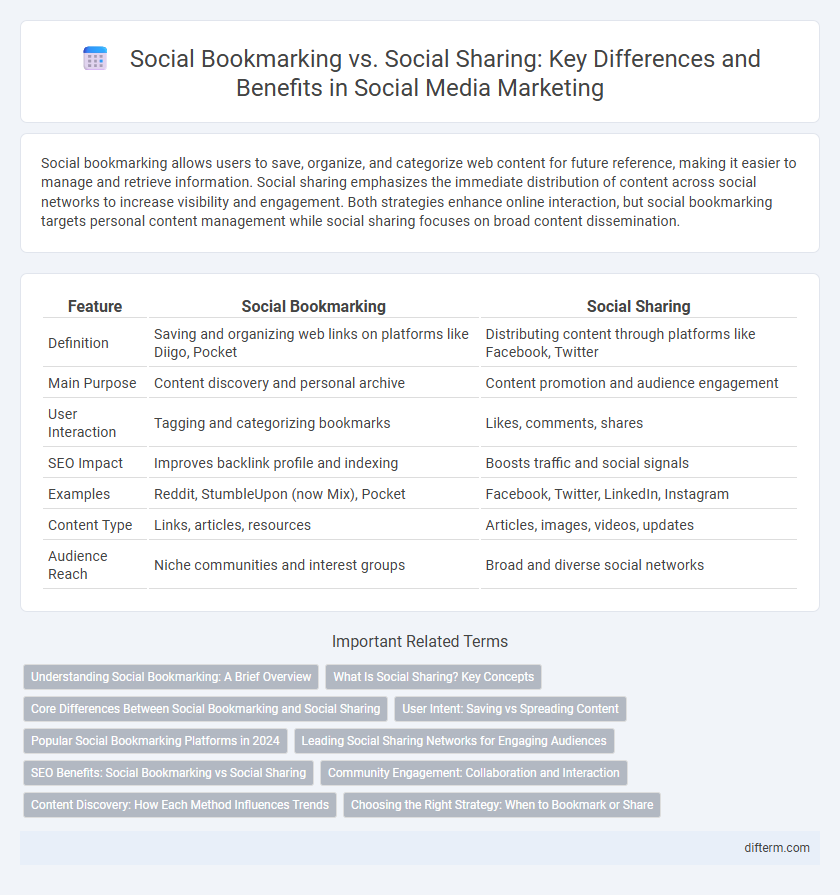Social bookmarking allows users to save, organize, and categorize web content for future reference, making it easier to manage and retrieve information. Social sharing emphasizes the immediate distribution of content across social networks to increase visibility and engagement. Both strategies enhance online interaction, but social bookmarking targets personal content management while social sharing focuses on broad content dissemination.
Table of Comparison
| Feature | Social Bookmarking | Social Sharing |
|---|---|---|
| Definition | Saving and organizing web links on platforms like Diigo, Pocket | Distributing content through platforms like Facebook, Twitter |
| Main Purpose | Content discovery and personal archive | Content promotion and audience engagement |
| User Interaction | Tagging and categorizing bookmarks | Likes, comments, shares |
| SEO Impact | Improves backlink profile and indexing | Boosts traffic and social signals |
| Examples | Reddit, StumbleUpon (now Mix), Pocket | Facebook, Twitter, LinkedIn, Instagram |
| Content Type | Links, articles, resources | Articles, images, videos, updates |
| Audience Reach | Niche communities and interest groups | Broad and diverse social networks |
Understanding Social Bookmarking: A Brief Overview
Social bookmarking involves saving, organizing, and managing links to web pages online for easy access and sharing within specific communities. This method enhances content discovery by categorizing bookmarks with tags, enabling users to quickly retrieve and share relevant information. Unlike social sharing, which primarily focuses on distributing content across various social media platforms, social bookmarking emphasizes long-term content curation and personalized information management.
What Is Social Sharing? Key Concepts
Social sharing involves distributing content across social media platforms to increase visibility and engagement, enabling users to easily share articles, videos, or images with their networks. Key concepts include user-generated content, viral interaction, and platform integration, which facilitate broader reach and real-time engagement. Unlike social bookmarking, which primarily saves content for personal reference, social sharing actively promotes content diffusion and connection among users.
Core Differences Between Social Bookmarking and Social Sharing
Social bookmarking involves saving and organizing web links on a platform for personal use or public discovery, emphasizing content curation and retrieval, while social sharing centers on distributing content through social networks to engage audiences and increase visibility. Social bookmarking sites like Pocket and Diigo allow users to categorize and tag links for future access, whereas social sharing platforms such as Facebook and Twitter promote real-time interaction and viral dissemination of content. The core difference lies in bookmarking's focus on content management and sharing's emphasis on immediate audience engagement and social interaction.
User Intent: Saving vs Spreading Content
Social bookmarking focuses on user intent to save and organize content for later reference, enabling efficient retrieval and personal curation. Social sharing aims at spreading content quickly across networks to increase visibility and engagement among a broader audience. Understanding these distinct user behaviors helps optimize digital strategies for content discovery and distribution.
Popular Social Bookmarking Platforms in 2024
Popular social bookmarking platforms in 2024 include Pocket, Diigo, and Pinboard, which enable users to save, organize, and categorize web content for future reference. These platforms emphasize content curation and discovery, allowing users to create personalized libraries of valuable resources. Unlike social sharing sites such as Facebook and Twitter, which prioritize real-time content distribution and interaction, social bookmarking services focus on long-term access and collaborative knowledge management.
Leading Social Sharing Networks for Engaging Audiences
Leading social sharing networks like Facebook, Twitter, and Instagram enable users to distribute content instantly, maximizing audience engagement through real-time interaction and personalized feeds. Social bookmarking platforms such as Pinterest and Pocket focus on content curation and organization, allowing users to save and categorize links for future reference. Prioritizing social sharing networks enhances visibility and drives immediate traffic, while bookmarking serves as a long-term content discovery strategy.
SEO Benefits: Social Bookmarking vs Social Sharing
Social bookmarking enhances SEO by creating high-quality backlinks from reputable bookmarking sites, improving site authority and organic rankings. Social sharing boosts SEO through increased content visibility and user engagement, driving more traffic and potential backlinks. Combining both strategies maximizes visibility, referral traffic, and search engine credibility for improved overall SEO performance.
Community Engagement: Collaboration and Interaction
Social bookmarking enables community engagement by allowing users to collaboratively categorize, tag, and organize content, fostering a shared knowledge base. Social sharing drives interaction through seamless content distribution across networks, encouraging comments, discussions, and real-time feedback. Both practices enhance collaboration, but social bookmarking emphasizes collective content curation while social sharing prioritizes immediate communication and viral reach.
Content Discovery: How Each Method Influences Trends
Social bookmarking platforms, such as Pocket and Diigo, enable users to save and organize content for future reference, fostering niche communities that drive deep content discovery and trend formation over time. Social sharing on platforms like Facebook and Twitter triggers immediate dissemination and viral spread of content, rapidly influencing mainstream trends and public conversations. The differing dynamics between bookmarking's long-term content curation and sharing's instantaneous visibility shape how digital trends emerge and evolve across audiences.
Choosing the Right Strategy: When to Bookmark or Share
Social bookmarking is ideal for organizing and saving valuable content for future reference, boosting SEO through link building and niche-specific visibility. Social sharing excels in amplifying content reach, driving immediate engagement, and fostering community interaction across platforms like Facebook, Twitter, and LinkedIn. Choosing the right strategy depends on goals: use bookmarking to enhance discoverability and save resources, and sharing to maximize real-time exposure and social interaction.
social bookmarking vs social sharing Infographic

 difterm.com
difterm.com